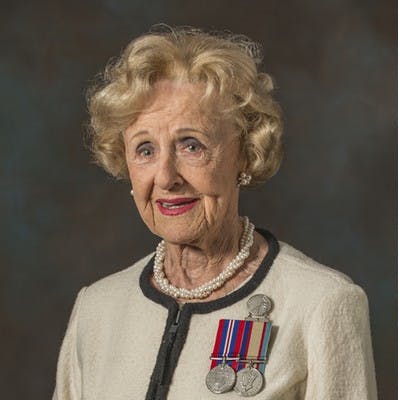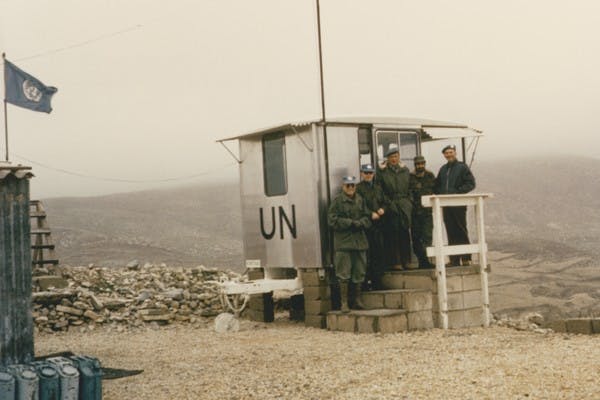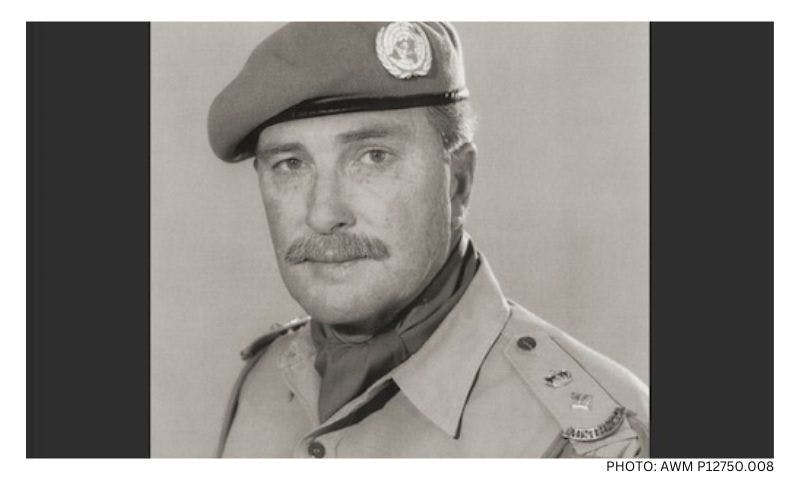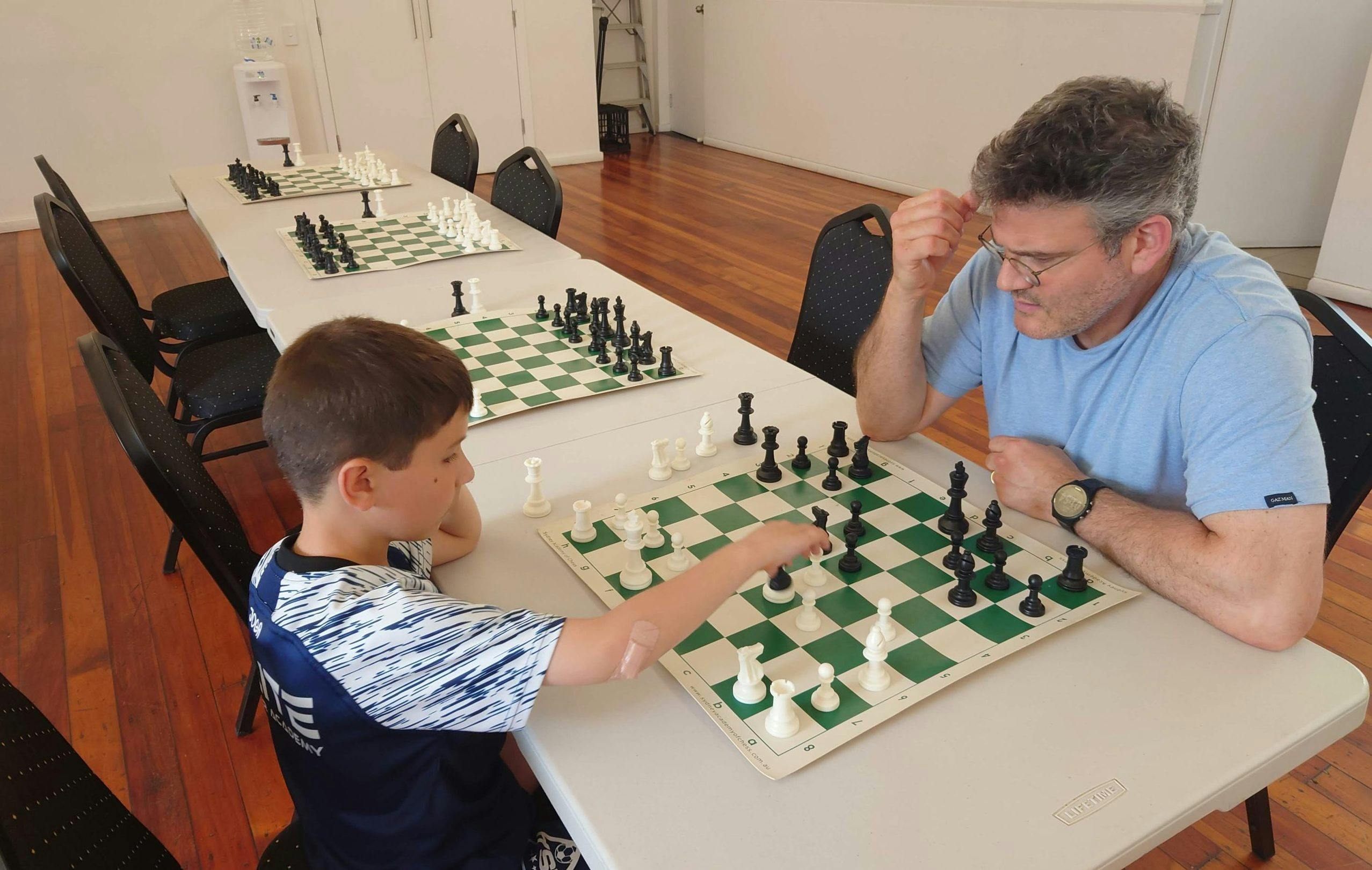Published: 21 September 2023
Last updated: 5 March 2024
Colonel Keith Howard and his wife Joan were in the Golan Heights on a UN post-1967 truce posting, when the sky suddenly filled with screaming jets.
Colonel Keith Howard - one of Australia’s original Blue Berets - and his wife Joan were due to go on a few days hard-earned leave in October 1973 when Syria and Egypt launched the Yom Kippur war, on October 6.
As the officer-in-charge of the Tiberias Control Centre with command of the Golan Heights, Perth-born Colonel Howard was responsible for 43 fellow officers of the United Nations Truce Supervision Organisation (UNTSO). He immediately returned to the front line.
A photo shows him visiting one of the makeshift observation posts in the battle ground, little more than a man’s shed today. According to the Australian War Memorial (AWM): “Shells from the first artillery salvo landed on one of the observation posts under Keith’s command (leaving the camp and observation trailer) a flaming inferno”.
“The two observers had narrowly avoided the barrage and, for the next week, maintained radio contact to report on the battle raging around them.”
Keith had served at Tobruk, El Alamein and Borneo, but Joan wrote to her two adult daughters - whom Keith had adopted - that “he says he’s never seen anything like this”.
Occasionally he would drive home from the war zone in the Golan Heights to their rented cottage at Tiberias by the Sea of Galilee to see Joan. Not one to mince words, Joan wrote to Zoe, the daughter they shared together, that Keith arrived “filthy”, “terribly tired” and smelling “of death”.
Joan - who had served in World War 2 in the Voluntary Aid Detachment (VAD) as a nurse and later became a distinguished archaeologist, born from the couple’s deep love of the Middle East - was herself barely 60km from the battlefield.

“I could watch the daily air battles overhead, the planes crashing into the lake, the air-to-ground missiles spitting from the Israeli planes onto the Syrians and from our balcony the three-day tank battle which raged across the other side of the lake – 400 tanks on each side,” she wrote to Zoe.
Despite the war being so close, when the UN offered to evacuate the observers’ families to Cyprus, Joan refused to go, despite the constant “thumpings and great thuds” of battle and the incessant scream of jets “trailing their white tails and breaking the sound barrier over and over.
“The very last thing I am doing is leaving!” Joan wrote to Zoe. “I’m fit and fine and not worried about the situation at all – only Keith’s welfare. And I couldn’t look after that from Cyprus.”
Several other wives (UNTSO was a masculine preserve in those days) stayed too, gathering at the Mixed Armistice Commission in Tiberias - the UN control centre - to chat and play whist with other families attached to the UNTSO.
I could watch the air battles overhead, the planes crashing into the lake... and from our balcony the tank battle.
Joan Howard writing to her daughter Zoe
After a few days into the war, Joan wrote to Zoe telling her all the UNTSO families were “in good health and heart but some wives (quite naturally) not too keen on all the noise… [since] they maybe have small children who get a bit frightened.”
When the ceasefire was announced on October 25, Colonel Howard was responsible for establishing a truce line.
Joan wrote to her family explaining that there isn’t “an observation post left, of course… they are non-existent or such a complete shambles that not even a pair of binoculars or a camp stretcher is left.”
Keith and his team did such a great job that the Howards were sent to Cairo, where he helped create and enforce a buffer zone between Egypt and Israel.

Golan Heights outpost in Israeli-occupied Syria, with Keith Howard, left (AWM P12750.006)
Historian Dr Bryce Abraham - curator of Private Records at the AWM - spoke to Joan in Perth on the phone after her husband died in 2012. “There were several Australians who served in UNTSO during the 1950s, 60s and 70s. “During the Yom Kippur War, there would have been half a dozen.”
The Howards had been in Israel since 1967 and their arrival wasn’t smooth either, Dr Abraham explains. On Keith’s very first day in the UN’s headquarters in Israeli Jerusalem - when the city was still divided - the surrounding Arab nations, led by Egypt's president Gamal Adbel Nasser - launched a war to obliterate the country created in 1948 after the Holocaust.
It was June 5, the opening of what we now know as “the Six Day War”. The Australian, who had served in the 2/16th Battalion, was injured by shrapnel. “There was naturally a bit of confusion that day,” says Dr Abraham, who specialises in Australian peace-keeping efforts.
“Keith caught a bit of shrapnel in his thigh from a ricochet. He was in Government House, which had been leased to the United Nations.”
Joan received word Keith had been injured, but didn’t know what happened. Keith made jokes in his correspondence.
Joan and then teenage Zoe were on a ship from Australia to Israel when they got the news.
“Joan received word Keith had been injured, but she didn’t know what happened,” the historian continues. “Joan was really worried, but Keith made various jokes in his correspondence, putting her at ease, telling her he could still walk.”
Dr Abraham says Joan deliberately rented apartments with short-term leases near the front lines because Keith had to move so frequently.
Socially, Joan made friends with other UNTSO wives - playing tennis and card games - because they were forbidden from meeting locals (either Jews or Arabs) for fear of being seen as partial.
However, Joan did record a remarkable encounter with “a cleaning man” in Palestinian-dominated Gaza after Keith had been stationed there. “One night there was a lot of blowing up and (Keith) did not return (at 5pm) as usual. It was pretty bad.
“I didn’t know until (the next) morning that the (cleaning) man slept on the floor outside my door all night, because he thought, ‘maybe she’s scared, maybe I can help’. That was very very kind.”
Keith was Joan’s second husband. “Her first husband, Anthony, was killed in a flying accident while training for the RAAF in 1945,” Dr Abraham explains. “He was only 24.”
Keith Howard was a handsome man with a moustache, a cross between Clark Gable and David Niven. He married Joan in 1947. “Joan was a formidable woman,” Dr Abraham says. “I never met her, but I came across their collection at AWM which was donated after Keith died.”
In 1950, she and Keith won a nationwide radio contest to find “Mr and Mrs Australia”. Around 15,000 couples entered. But Joan and Keith won - the prizes being a seven-week visit to England, a new car, and new wardrobes, according to the AWM website.
Before Keith died, he wrote that he had “achieved something” contributing “to the wellbeing of various groups of people”.
But only “with the wonderful support of my wife and my family who have to some degree participated in the pleasures and the dangers and the excitements”.
Phoot: Colonel Keith Howard, C. 1967-77 (AWM P12750.008)




